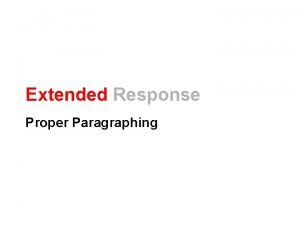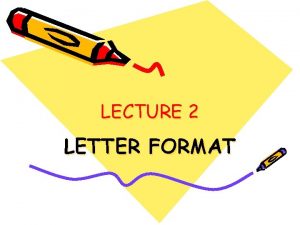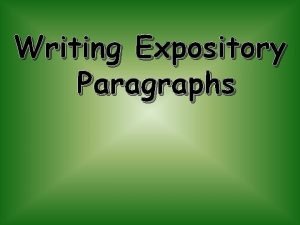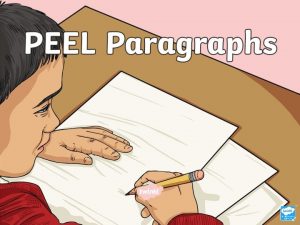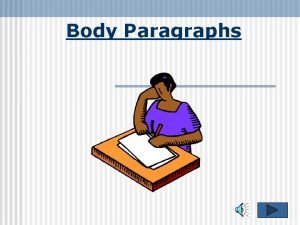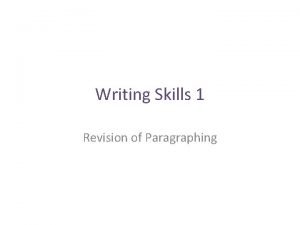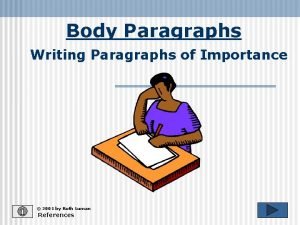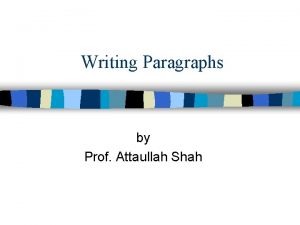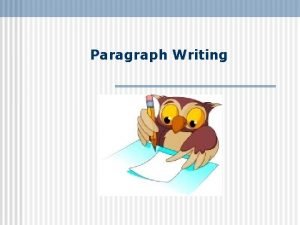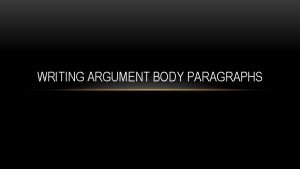Writing Paragraphs that Work Paragraphing and Meaning A













- Slides: 13

Writing Paragraphs that Work

Paragraphing and Meaning • • A well-written paragraph makes your writing more effective. Each paragraph should focus on a single main point. This is called “Paragraph Unity” Every paragraph break tells readers that the document is moving on to a new idea, or expanding further on an existing one. The paragraph should guide readers smoothly from point to point. This is called “Paragraph Cohesion. ”

Paragraph Building • • Paragraph writing entails many of the same details as writing an entire document. A paragraph should introduce its main ideas clearly and provide supporting details. The main point of a paragraph will often appear in a topic sentence. Readers will often use the first sentence or two of a paragraph to build expectations

Unity • • A unified paragraph is carefully focused on a single main point. Ensuring unity begins before writing: the writer should decide what function the paragraph serves in the document, and what point it needs to make.

A Paragraph might: • Introduce a new idea. • Support a point made earlier. • Summarise the main points of the document. • Serve a specialised function, such as emphasis or transition.

The Topic Sentence • • The topic sentence is a tool, not a rule: use it to decide what must be in the paragraph while drafting, and to edit for unity afterwards. Even a paragraph that will not need a topic sentence should be unified, so an informal topic sentence, even one that never makes it to paper, can be useful.

Placement of the Topic Sentence • • The topic sentence usually appears at the beginning of the paragraph, but it can be elsewhere or may not appear at all. If readers might disagree with the main point, put the topic sentence last. Or a paragraph may start with a short transitional sentence, with the topic sentence second. Sort or descriptive paragraphs may not have a topic sentence at all.

Unity Exercise

Coherence • Avoid short, choppy sentences. • Make sure your sentences follow a logical sequence (try revising this paragraph). • Use Transitions and Connecting Words to lead readers from point to point. • Use pronouns to link your sentences together.

Coherence Exercise

Paragraph Length Short Paragraphs • Easy to digest • Too many short paragraphs makes a message seem choppy Long Paragraphs • Explore complex ideas in depth • Avoid long paragraphs at the beginning or end of a document. Introductions and conclusions should be concise, clear and reader-friendly A combination of long and short paragraphs is best for readability.

Special Purpose Paragraphs • • Introductions Transitions Emphatic Paragraphs Conclusions

Checklist for Paragraphs • See Writing Paragraphs that Work module in the online classroom! • Now: Evaluate and revise the paragraphing in this memo.
 Extended response examples
Extended response examples Lexis letter
Lexis letter Phân độ lown ngoại tâm thu
Phân độ lown ngoại tâm thu Block av độ 2
Block av độ 2 Thơ thất ngôn tứ tuyệt đường luật
Thơ thất ngôn tứ tuyệt đường luật Thơ thất ngôn tứ tuyệt đường luật
Thơ thất ngôn tứ tuyệt đường luật Chiến lược kinh doanh quốc tế của walmart
Chiến lược kinh doanh quốc tế của walmart Tìm vết của đường thẳng
Tìm vết của đường thẳng Hãy nói thật ít để làm được nhiều
Hãy nói thật ít để làm được nhiều Tôn thất thuyết là ai
Tôn thất thuyết là ai Gây tê cơ vuông thắt lưng
Gây tê cơ vuông thắt lưng Sau thất bại ở hồ điển triệt
Sau thất bại ở hồ điển triệt Example of expository paragraph about education
Example of expository paragraph about education P.e.e.l. paragraph
P.e.e.l. paragraph
